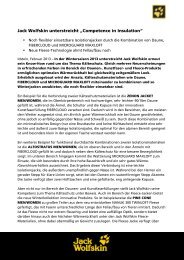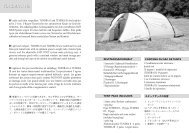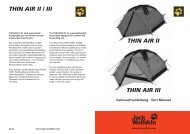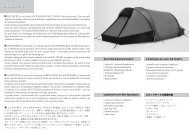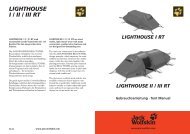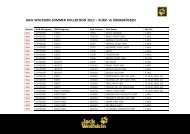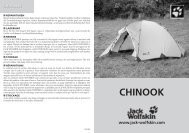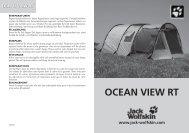The ZDHC Joint Roadmap - Jack Wolfskin
The ZDHC Joint Roadmap - Jack Wolfskin
The ZDHC Joint Roadmap - Jack Wolfskin
Create successful ePaper yourself
Turn your PDF publications into a flip-book with our unique Google optimized e-Paper software.
After the assessment, we will apply a transparent decision‐making process to assign chemicals into the other<br />
two parts of this workstream, specifically to the phase out or research actions.<br />
What will we achieve by 2015?<br />
<br />
<br />
A transparent process for assessing and prioritising chemicals that is clearly documented and reviewed by<br />
key stakeholders with ongoing bi‐annual review cadence.<br />
A publically available list of chemical substances that are targeted for phase out and/or research.<br />
It is important to note that the objectives for this Workstream 1, after initial establishment in the formative<br />
year (2013), will be constant. <strong>The</strong> process also should remain consistent as we use it to respond to emerging<br />
and new information each year.<br />
Near-term Action Plan<br />
Action: Provide a list of chemical substances and prioritise for phase out or further research<br />
Starting with existing sources, including the REACH Candidate List of Substances of Very High Concern (SVHC), the<br />
Bluesign System Substances List (BSSL), the SIN List (Substitute It Now list from ChemSec) used in textiles, additional<br />
textile chemicals identified by KEMI, the Government of China, and brand RSLs, we will 1) create a list that contains<br />
information for each of these substances that will allow us to 2) develop a prioritisation framework and criteria to rank<br />
these chemicals for action or research.<br />
Working in partnership with stakeholders and the <strong>ZDHC</strong> Technical Advisory Committee, we will prioritise the list of<br />
chemicals with key criteria that may include:<br />
<br />
<br />
<br />
<br />
<br />
<br />
<br />
How the chemicals are used in the supply chain, in what types of formulations do they typically occur and in which<br />
processes are they typically used<br />
Where chemicals are used (e.g., are they a direct input or do they appear as a contaminant)<br />
How much of a chemical is used across the industry<br />
Why they are hazardous<br />
Available alternatives<br />
Chemical class<br />
REACH prioritization process and other regulatory frameworks<br />
This information will help inform a transparent prioritisation hierarchy. This work will be done in partnership with<br />
stakeholders to ensure the hierarchy is sound. <strong>The</strong> ultimate determination from this work is to identify whether<br />
chemicals are targeted for phase out/restriction or whether we need to conduct more research on use and alternatives.<br />
Many of these chemicals are ones that have historically been targeted in the supply chain and will be quickly moved to<br />
action (e.g., organic solvents). However, this process also will help bring additional chemicals of concern to our attention,<br />
so we can actively push the industry toward cleaner operation and discharge.<br />
We will document our approach.<br />
Results Deliverables Timeline<br />
Ongoing methodology to identify and List of priority chemicals for further<br />
flag priority chemical substances action<br />
Creation of a prioritised list of<br />
chemicals with known hazards where<br />
each chemical has been populated<br />
with additional information such as<br />
chemical class and use<br />
Documented and transparent process<br />
<strong>The</strong> first deliverables will be<br />
completed by August 2013.<br />
However, this will be ongoing work<br />
that will occur at regular (to be<br />
specified) intervals.<br />
4-3



